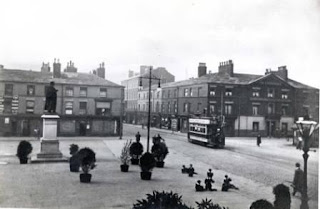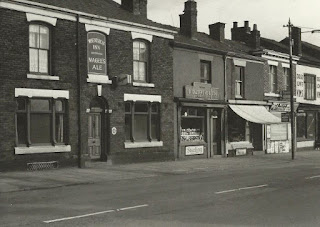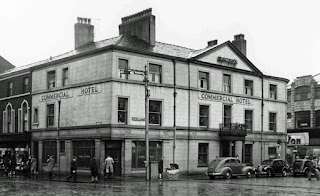A splendidly atmospheric view of the Commercial Hotel on what looks like a bleak autumn day but which was actually taken on 21 June 1954. Image from the Bolton Library and Museums collection. Copyright Bolton Council.
Of all the pub closures in Bolton few can have been as
controversial at that of the Commercial Hotel, which stood on the corner of the
Victoria Square. The pub closed in April1972 after a bitter battle which even
reached the debating chamber at the Town Hall.
That debate and the pub's subsequent demolition marked the end of
a local landmark that began life in 1809 as the Commercial Tavern. In those
days, what is now Victoria Square was then the New Market Place and the
Commercial was popular with stallholders and customers from the nearby market.
The Gatty family, William and Ann, were in charge during
the early years. William Gatty was listed as the innkeeper from 1814 to 1817
but the 1818 Pigot’s Directory shows Ann Gatty as the proprietor.
The Gattys were succeeded by the Padburys with Thomas
Padbury listed as the proprietor in 1821 and he was succeeded by Samuel
Padbury, presumably his son.
The Padburys made their mark and it could be argued that the
Commercial’s elevation to one the position of one of the principle inns in the
town was largely due to their efforts. The hotel was attractive enough to host
a regular season of balls and assemblies in the 1820s, at its Assembly Rooms.[1]
The Commercial also hosted a subscription library, which
could be regarded as one of the predecessors to Bolton Library, with newsrooms
for the manufacturers, professional people and gentry of Bolton. While this was by no means the first reading library in the
town, in 1824 it became the highly respectable, reforming Exchange Newsroom and
was regarded as the natural resort of gentlemen of all political colours. [1]
The Exchange Newsroom outgrew the pub and moved to a
building on the other side of what was then the Market Square – now the Town
Hall Square. The Exchange Newsroom became Bolton Library in 1853.
Its former premises still stand as a betting shop having been a branch of the
Nationwide Building Society until 2009.
The 1841 Census shows John Walmsley as the proprietor at the Commercial but he
moved on and business began an association with the Brandwood family that
lasted for over 30 years.
John Brandwood was the licensee and his standing as the
landlord of one of the principal inns in the town meant that he was able to
move in high circles.
For many years Brandwood was the president of the Bolton
Licensed Victuallers Association. He became a local councillor: a Liberal
representing Derby Ward from 1858 to 1867. One election, in 1861, saw two seats
up for grabs and was unusual in that all four candidates represented the Liberal Party. Brandwood
and Councillor Constantine were elected but it is worth pointing out that in brief
note to the election in his book Annals Of Bolton, John Clegg noted that the
two defeated candidates represented “the teetotal interest”.
However, Brandwood must have fallen out with the Liberal
Party. In the 1867 election he stood as an Independent candidate and was
defeated by two Liberals. He later jumped to the Conservatives but
was defeated in 1873 when he came fourth out of four candidates in Exchange
ward, two Liberals defeating the two Tories. [2]
Brandwood died in February 1878 in his 66th year.
His name lives on in Brandwood Street and its eponymous primary school situated
off Willows Lane. The Commercial was taken over by Brandwood’s daughter, Sarah
Ann and her husband, John Priestley, who married just a few months after John
Brandwood’s death. Priestley also became a councillor spending three years
representing the Conservatives from 1879 to 1882 in the same Exchange ward that
had rejected his father-in-law just a few years earlier.
Sadly, Priestley died a young man. The former chemist turned
licensed victualler died at the Commercial Hotel in June 1885 at the age of 43.
The Commercial was eventually taken over by Magee Marshall
and by the early seventies it was in the hands of Greenall Whitley, who had
bought out Magee’s in 1958.
Greenall’s put the Commercial up for sale in 1971. Even at
that stage pubs in the area close to the Town Hall were finding it difficult to
attract custom. The nearby
Crown and Cushion was closed around the same time
the Commerical was put up for sale. Would the decision in 1969 to close off
Newport Street, Oxford Street and Victoria Square mark the end for an already
struggling pub? Perhaps it made no difference.
But the decision to sell the
Commercial caused an outcry in the town. It was bought by Mothercare who
proposed to demolish the pub and replace it with a retail store. The issue was
brought up in the Town Hall where Councillor Hanscomb told those opposing the
plans not to be “silly and sentimental”. As is often the case, the Commercial
would have thrived had those in opposition to its closure chosen to patronise the
pub.
The Commerical closed in April 1972. It was demolished in
November of that year and in August 1974, Mothercare opened on the site. The
retailer remained there for 36 years until 2010 when it closed the store and
sold the site to Barclay’s Bank. [3]
[1] Leisure In Bolton,
1750-1900, Robert Poole, 1982
[2] Annals Of Bolton, John Clegg, 1888
[3]
Bolton News, 16 December 2009. Retrieved 16 November
2014.
Due to its proximity to the Town Hall, the Commercial was one of the most-photographed pubs in the town. Here are a few images from the Bolton Library and Museum Services collection. All images are copyright Bolton Council.
 |
| 1910 |
 |
| 1957 |
 |
| A night-time shot from 1958 |
 |
| 1967 |

















